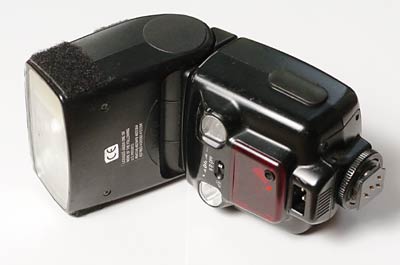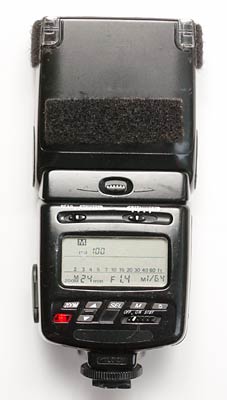 Anyone who has been reading Strobist for a while knows that I think the Nikon SB-24 is the best bet for the starving student's entré into the world of off-camera manual flash. With an external PC connection and full manual control over a 5-stop range, it has what you need without your paying for what you don't.
Anyone who has been reading Strobist for a while knows that I think the Nikon SB-24 is the best bet for the starving student's entré into the world of off-camera manual flash. With an external PC connection and full manual control over a 5-stop range, it has what you need without your paying for what you don't.But for someone with a little flexibility in their budget, the more recent (circa mid-90's) SB-26 may be a better call. And if you are moving from just one flash to two, the SB-26 is a no-brainer. It can be had for around $100 at the time of this writing.
NOTE: If the earlier readers swoop in and snarf up the sub-$100 examples, don't blame me. Well, OK, I guess technically you could blame me, but they were just faster on the draw. So try to wait for more stock or troll eBay for a while to grab a good deal. But bear in mind that you are likely to be bidding against each other for the few days after May 15th, when this post goes up.
The SB-26 does everything the SB-24 does, plus the following:
• Full manual control over a 7 f/stop range.
• A built-in bounce card.
• A built-in diffuser panel for ultra-wide beam width.
• A "delay" function (more on that later.)
• A built-in optical slave. (Schwing!)
Now, before I go into detail on the features, I want to give you a word or two about keeping these vintage flashes alive.
First, USE THEM OFF CAMERA. I'm not making a value judgement (for once) on your lighting skills. It's just that the hot-shoe foot is the vulnerable point on these flashes. An SB-24, or -26, or whatever, could theoretically last you a whole career if it is happily firing on a stationary stand. That's because there is no torque on the hot shoe foot.
But if you are shooting on-camera, say, stalking Sean Penn or English soccer hooligans, well, that's another kettle of fish. You might catch an elbow (or a brick) to the head and your flash foot could go 'bye-bye' real fast.
Even if you use them on stands, a good policy is to not stick them straight out so all of the pressure is on a horizontally-mounted shoe foot. Mount them vertically (or as near to vertical as is practical) and use the swivel head to do the pointing. Way less torque. Way happier flash foot.
That said, if you snap one off, all is not lost. There is a good discussion (and link resources) for getting it fixed (even DIY-style) over at Sportsshooter. (Link will open in a new window directly to the discussion.)
Now, back to our regularly scheduled programming.
 The seven f/stop range is really sweet, especially for close-up work. There are times when I have had to dumb that down even a couple more stops with neutral density filters. One-sixteenth power can be way too much at a few inches in distance.
The seven f/stop range is really sweet, especially for close-up work. There are times when I have had to dumb that down even a couple more stops with neutral density filters. One-sixteenth power can be way too much at a few inches in distance.The "delay" mode is, as far as I know, unique to this model of flash. Here's how it works. Say you are using an on-camera flash in the auto (or TTL) mode. You can use the SB-26 in manual mode stuck out in the background somewhere as a back/rim/whatever light and it will wait until the other flash has finished firing before it fires.
Why is this important? Because if it fired at the same time, it could screw up the other flash trying to work in its auto or TTL mode. (Usually this means the main light would not put out enough light. That's bad.)
How does it know when the flash is done? It doesn't. There is simply a "delay" switch on front of the flash. (Set it to "d.")
Does it matter what kind/brand of camera/flash is used for the auto/TTL front light? Nope. (Sweet, huh?)
What does this cost me? Well, other than a few bucks more to get this flash instead of an SB-24 (or -25) it costs you a third of a stop on your max synch speed. Most SB/Nikon combos max out at a 250th synch. This setting limits you to 1/200th, to account for the delay. Not an issue in the environments where you are likely to need to be filling dark backgrounds.
Now, for the other feature that makes this an ideal second light: Built-in optical slave. It'll see your other flash fire and fire the SB-26, either in "real time" or in the delay mode. For our purposes, it'll usually be real-time.
Now, this is not a fantastic slave. But for typical environmental portrait set-ups, for instance, it works great. You can help it along by making the SB-26 the strobe that fires the weaker light of the two, if there is a difference. Theory is, if one flash is going to set off the other (using light) you want the slaved flash to be receiving the bigger shot of light - not the other way around.
The other way to increase your efficiency is to point the front panel (that's where the slave eye is) of the SB-26 at the other light. Since the head rotates and tilts, this is almost never a problem. And of the SB-26 is firing into an umbrella, you're golden. That umbrella acts as a big relector, catching your main light and sending it right into the sensor.
These babies sold for $350 (and adjust that for ten years of inflation) back in the day. And now people have visions of "$B-800's" dancing in their heads, so they sell them for a song. Why, thank you, Mr. Rich Photo Hobbyist Guy.
All in all, a great little light. And believe me, if I was still looking to pick up a couple more of them, you would not be reading this article yet.





0 comments:
Post a Comment